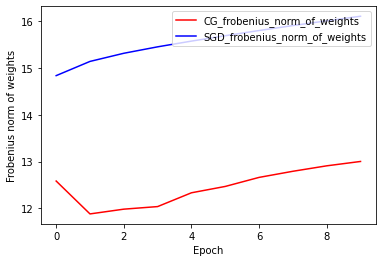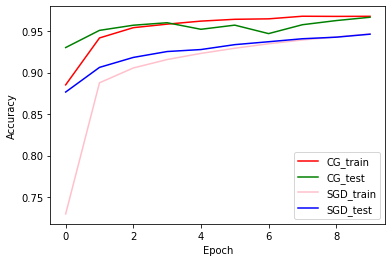 View on TensorFlow.org View on TensorFlow.org
|
 Run in Google Colab Run in Google Colab
|
 View source on GitHub View source on GitHub
|
 Download notebook Download notebook
|
Overview
This notebook will demonstrate how to use the Conditional Graident Optimizer from the Addons package.
ConditionalGradient
Constraining the parameters of a neural network has been shown to be beneficial in training because of the underlying regularization effects. Often, parameters are constrained via a soft penalty (which never guarantees the constraint satisfaction) or via a projection operation (which is computationally expensive). Conditional gradient (CG) optimizer, on the other hand, enforces the constraints strictly without the need for an expensive projection step. It works by minimizing a linear approximation of the objective within the constraint set. In this notebook, you demonstrate the appliction of Frobenius norm constraint via the CG optimizer on the MNIST dataset. CG is now available as a tensorflow API. More details of the optimizer are available at https://arxiv.org/pdf/1803.06453.pdf
Setup
pip install -U tensorflow-addonsimport tensorflow as tf
import tensorflow_addons as tfa
from matplotlib import pyplot as plt
# Hyperparameters
batch_size=64
epochs=10
Build the Model
model_1 = tf.keras.Sequential([
tf.keras.layers.Dense(64, input_shape=(784,), activation='relu', name='dense_1'),
tf.keras.layers.Dense(64, activation='relu', name='dense_2'),
tf.keras.layers.Dense(10, activation='softmax', name='predictions'),
])
Prep the Data
# Load MNIST dataset as NumPy arrays
dataset = {}
num_validation = 10000
(x_train, y_train), (x_test, y_test) = tf.keras.datasets.mnist.load_data()
# Preprocess the data
x_train = x_train.reshape(-1, 784).astype('float32') / 255
x_test = x_test.reshape(-1, 784).astype('float32') / 255
Define a Custom Callback Function
def frobenius_norm(m):
"""This function is to calculate the frobenius norm of the matrix of all
layer's weight.
Args:
m: is a list of weights param for each layers.
"""
total_reduce_sum = 0
for i in range(len(m)):
total_reduce_sum = total_reduce_sum + tf.math.reduce_sum(m[i]**2)
norm = total_reduce_sum**0.5
return norm
CG_frobenius_norm_of_weight = []
CG_get_weight_norm = tf.keras.callbacks.LambdaCallback(
on_epoch_end=lambda batch, logs: CG_frobenius_norm_of_weight.append(
frobenius_norm(model_1.trainable_weights).numpy()))
Train and Evaluate: Using CG as Optimizer
Simply replace typical keras optimizers with the new tfa optimizer
# Compile the model
model_1.compile(
optimizer=tfa.optimizers.ConditionalGradient(
learning_rate=0.99949, lambda_=203), # Utilize TFA optimizer
loss=tf.keras.losses.SparseCategoricalCrossentropy(),
metrics=['accuracy'])
history_cg = model_1.fit(
x_train,
y_train,
batch_size=batch_size,
validation_data=(x_test, y_test),
epochs=epochs,
callbacks=[CG_get_weight_norm])
Epoch 1/10 938/938 [==============================] - 3s 3ms/step - loss: 0.3808 - accuracy: 0.8852 - val_loss: 0.2282 - val_accuracy: 0.9301 Epoch 2/10 938/938 [==============================] - 2s 2ms/step - loss: 0.1941 - accuracy: 0.9417 - val_loss: 0.1697 - val_accuracy: 0.9508 Epoch 3/10 938/938 [==============================] - 2s 2ms/step - loss: 0.1525 - accuracy: 0.9540 - val_loss: 0.1494 - val_accuracy: 0.9570 Epoch 4/10 938/938 [==============================] - 2s 2ms/step - loss: 0.1376 - accuracy: 0.9583 - val_loss: 0.1346 - val_accuracy: 0.9600 Epoch 5/10 938/938 [==============================] - 2s 2ms/step - loss: 0.1239 - accuracy: 0.9620 - val_loss: 0.1573 - val_accuracy: 0.9521 Epoch 6/10 938/938 [==============================] - 2s 2ms/step - loss: 0.1187 - accuracy: 0.9641 - val_loss: 0.1538 - val_accuracy: 0.9571 Epoch 7/10 938/938 [==============================] - 2s 2ms/step - loss: 0.1130 - accuracy: 0.9647 - val_loss: 0.1625 - val_accuracy: 0.9469 Epoch 8/10 938/938 [==============================] - 2s 2ms/step - loss: 0.1069 - accuracy: 0.9678 - val_loss: 0.1347 - val_accuracy: 0.9576 Epoch 9/10 938/938 [==============================] - 2s 2ms/step - loss: 0.1055 - accuracy: 0.9676 - val_loss: 0.1173 - val_accuracy: 0.9626 Epoch 10/10 938/938 [==============================] - 2s 2ms/step - loss: 0.1049 - accuracy: 0.9678 - val_loss: 0.1102 - val_accuracy: 0.9666
Train and Evaluate: Using SGD as Optimizer
model_2 = tf.keras.Sequential([
tf.keras.layers.Dense(64, input_shape=(784,), activation='relu', name='dense_1'),
tf.keras.layers.Dense(64, activation='relu', name='dense_2'),
tf.keras.layers.Dense(10, activation='softmax', name='predictions'),
])
SGD_frobenius_norm_of_weight = []
SGD_get_weight_norm = tf.keras.callbacks.LambdaCallback(
on_epoch_end=lambda batch, logs: SGD_frobenius_norm_of_weight.append(
frobenius_norm(model_2.trainable_weights).numpy()))
# Compile the model
model_2.compile(
optimizer=tf.keras.optimizers.SGD(0.01), # Utilize SGD optimizer
loss=tf.keras.losses.SparseCategoricalCrossentropy(),
metrics=['accuracy'])
history_sgd = model_2.fit(
x_train,
y_train,
batch_size=batch_size,
validation_data=(x_test, y_test),
epochs=epochs,
callbacks=[SGD_get_weight_norm])
Epoch 1/10 938/938 [==============================] - 2s 2ms/step - loss: 1.0268 - accuracy: 0.7297 - val_loss: 0.4595 - val_accuracy: 0.8765 Epoch 2/10 938/938 [==============================] - 2s 2ms/step - loss: 0.4025 - accuracy: 0.8876 - val_loss: 0.3362 - val_accuracy: 0.9062 Epoch 3/10 938/938 [==============================] - 2s 2ms/step - loss: 0.3292 - accuracy: 0.9055 - val_loss: 0.2908 - val_accuracy: 0.9182 Epoch 4/10 938/938 [==============================] - 2s 2ms/step - loss: 0.2927 - accuracy: 0.9157 - val_loss: 0.2666 - val_accuracy: 0.9253 Epoch 5/10 938/938 [==============================] - 2s 2ms/step - loss: 0.2668 - accuracy: 0.9230 - val_loss: 0.2495 - val_accuracy: 0.9277 Epoch 6/10 938/938 [==============================] - 2s 2ms/step - loss: 0.2462 - accuracy: 0.9293 - val_loss: 0.2285 - val_accuracy: 0.9336 Epoch 7/10 938/938 [==============================] - 2s 2ms/step - loss: 0.2283 - accuracy: 0.9347 - val_loss: 0.2155 - val_accuracy: 0.9371 Epoch 8/10 938/938 [==============================] - 2s 2ms/step - loss: 0.2137 - accuracy: 0.9392 - val_loss: 0.2004 - val_accuracy: 0.9407 Epoch 9/10 938/938 [==============================] - 2s 2ms/step - loss: 0.2002 - accuracy: 0.9428 - val_loss: 0.1957 - val_accuracy: 0.9426 Epoch 10/10 938/938 [==============================] - 2s 2ms/step - loss: 0.1889 - accuracy: 0.9467 - val_loss: 0.1813 - val_accuracy: 0.9462
Frobenius Norm of Weights: CG vs SGD
The current implementation of CG optimizer is based on Frobenius Norm, with considering Frobenius Norm as regularizer in the target function. Therefore, you compare CG’s regularized effect with SGD optimizer, which has not imposed Frobenius Norm regularizer.
plt.plot(
CG_frobenius_norm_of_weight,
color='r',
label='CG_frobenius_norm_of_weights')
plt.plot(
SGD_frobenius_norm_of_weight,
color='b',
label='SGD_frobenius_norm_of_weights')
plt.xlabel('Epoch')
plt.ylabel('Frobenius norm of weights')
plt.legend(loc=1)
<matplotlib.legend.Legend at 0x7f9601c18640>

Train and Validation Accuracy: CG vs SGD
plt.plot(history_cg.history['accuracy'], color='r', label='CG_train')
plt.plot(history_cg.history['val_accuracy'], color='g', label='CG_test')
plt.plot(history_sgd.history['accuracy'], color='pink', label='SGD_train')
plt.plot(history_sgd.history['val_accuracy'], color='b', label='SGD_test')
plt.xlabel('Epoch')
plt.ylabel('Accuracy')
plt.legend(loc=4)
<matplotlib.legend.Legend at 0x7f95c0088ac0>

